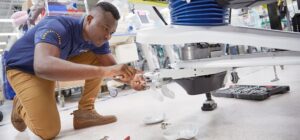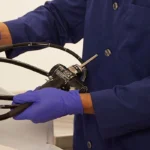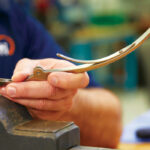Biomedical technicians are now responsible for more equipment than ever before. This responsibility and other related challenges are complicating hospital equipment service demands.
In 1997, Skynet – as introduced in the Terminator films – became self-aware. The outcome would forever change the world as Sarah Connor knew it.
In reality, we aren’t currently ruled by sentient robots, but in looking back at 1997, the use of medical technology has changed. At the time, the average number of medical devices per bed was five. Today, that number is over 13. Not only has this increased the complexity of delivering patient care, but many clinical engineering departments now face a rapidly-increasing service workload for general biomed equipment (infusion pumps, SCDs, monitors, etc.).
In fact, today’s average biomedical technician is now responsible for up to 1,200 devices. That workload is complicated by evolving regulatory standards, an increase in third-party service partnerships and the growth of software-enabled technology. Not to mention the rise in device connectivity and associated IT security challenges. All of which is pushing clinical engineering teams to rethink their equipment service strategies.
Make no mistake, the medical machines have risen, and they are here to stay.
What does this mean for your biomedical team? In working with thousands of hospitals across the country, we have uncovered three trends.
Trend 1: Biomedical Service Costs Have Increased by 90%
Today’s medical devices are increasingly more complex. This complexity requires more training and certification to service proficiently. From smart sensors to medical device integration, biomed departments also find themselves responding to the Internet of Things (IoT) by focusing on IT security, software management, and technology planning. Along with the rise of medical devices, equipment service, management, and administrative responsibilities have doubled maintenance costs.
Increases in technology and cost are relatively easy to understand. What’s more difficult to understand is why most biomedical departments have not expanded to meet this growing need – especially considering they are now tasked to manage a network of interconnected devices that require frequent software upgrades and take longer to service. Instead, hospital biomedical teams are asked to do more with less.
In fact, clinical engineering departments often must balance shifting priorities on a day-to-day basis. These include:
- Increasing technician service productivity through:
- Management of non-technical time (capital planning, advising, committee participation)
- Maintaining appropriate staffing (PTO, military leave, etc.)
- Sourcing and retaining qualified technicians
- Increasing equipment uptime
- Ensuring service compliance and regulatory documentation (e.g., The Joint Commission)
Without the appropriate resources to service equipment efficiently and cost-effectively, these clinical engineering departments are fighting a losing battle. Here’s what Tim Moss, Director of Resident Based Programs at Agiliti, and all-around clinical engineering expert, had to say on the subject:
Trend 2: Biomedical Equipment Repair Accounts for Only 60% of Technician Time
Staying up to date on the repair and maintenance requirements of a hospital’s inventory is extremely challenging, especially when so much of a biomedical technician’s time is not spent on achieving that goal. Through conversations with clinical engineering departments nationwide, we’ve discovered two leading culprits that impact technician productivity:
- Vendor Management
Today, a typical hospital relies on dozens of vendors to support day-to-day operations. This wide array of vendors increases the biomedical team’s responsibilities for coordinating dispatch service, managing parts and keeping up with paperwork. In fact, an average 300-bed hospital generates thousands of POs for parts and equipment annually. As one OR director commented:
- Time Spent Searching for Equipment
Conservatively, biomedical technicians spend an hour a week searching throughout a hospital for equipment to PM. While an hour per week may not sound like much, remember that the average technician is responsible for managing the service on up to 1,200 devices. The need to track down equipment impacts maintenance on other devices, leading to frequent backlogs. And if a device is discovered out-of-date on PMs, it poses a serious compliance risk.

Trend 3: 50% of All “Broken” Equipment isn’t Truly Broken
Nationwide, we’ve seen the same issue time and again. Upon inspection, half of all general biomedical equipment sent down to clinical engineering departments are found to be functional.
How is this possible?
Because clinicians don’t have the time to verify or troubleshoot equipment. So when it appears not to work, they send it down to the experts. Thus, time spent evaluating fully-functional equipment takes away from other service priorities, which can lead to increased equipment downtime.
So why not train the nurses?
Because it’s not their job. Clinicians should be focused on patient care. But also because increasing device sophistication is making it difficult for clinical teams to stay up-to-date on their equipment’s buttonology, alarming and functionality. As a result, a potentially easy-to-resolve “error code” turns into a service request for the biomedical team. Leaving one less device for caregivers to access for patient care. While biomed teams do their best to ensure that nurses get the equipment training they need – whether through the OEM, themselves or another vendor – it is yet another task on a biomedical department’s ever-growing “to-do” list.
The Future Outlook: Your Next Steps
True, these trends may not be ushering in a world controlled by Skynet and the machines. Yet, they are indicative of a changing environment that is forcing clinical engineering teams to do more. The problem is, without extra resources or a new approach to managing service on growing inventories of interconnected devices, biomedical teams end up spending more time on lower-end equipment instead of the higher-end, higher value equipment that is vital to driving hospital revenue.
We’ve seen hospitals succeed through partnerships that adjust their service delivery strategy to accommodate the increased volume and complexity of work expected from clinical engineering teams. With a range of skilled technical talent available across the country and partnerships with leading manufacturers, Agiliti helps hospitals access the right resources to reduce service costs. This includes providing flexible access to expert, qualified service technicians to provide preventive maintenance and repairs on-demand (hourly or block of time) across a range of modalities (infusion pumps, SCDs, monitors, etc.).
To contact a Agiliti representative about Clinical Engineering Services, please click the below link.
Visit our Resource Center to discover more, or learn more about Clinical Engineering Services.











